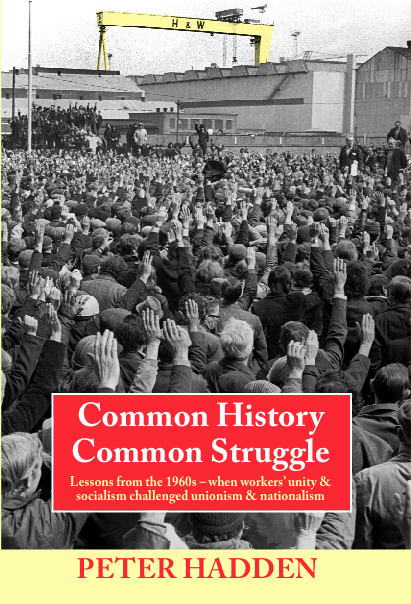Sectarianism or mass struggle?
Book review by Per-Åke Westerlund Rättvisepartiet Socialisterna(CWI Sweden)
Northern Ireland is usually described by media and politicians as an eternal battle between Catholics and Protestants. Peter Hadden’s last book, Common History Common Struggle, explains that the violent years from the 1970s onwards were far from inevitable, and that the common struggle of the working class is the key.

The English rule over Ireland was put under pressure by revolutionary workers’ struggles at the end of and after the First World War. London’s answer was the method of imperialism, to divorce and rule. In order to avoid revolution, Ireland was divided.
Two religious-sectarian states were formed. In the North, which continued to belong to Britain, Protestant loyalists and unionists got free hands. Gerrymandering with constituencies and voting rights gave the Unionist Party power throughout the period 1921-68, with armed loyalist gangs and the state attacking Catholics and the working class as a whole.
In the South, which formally became its own state only in 1937, reactionary parties in alliance with the Catholic Church took over an extremely poor country.
The division was aimed at consolidate a gap between Protestant and Catholic workers, who in 1919-20 struggled together in general strikes and mass struggles.
Everything changed 1968-69
The main theme of Common History Common Struggle is the years 1968-69. Peter Hadden (1950-2010) was then a new member of the Marxist organisation Militant, the founders of CWI, the international where Rättvisepartiet Socialisterna is the Swedish section. Throughout his political life, Peter Hadden was a leading activist and theorist, writing several important books on Northern Ireland and the national question.
Everything changed in Northern Ireland 1968-69. Decades of poverty and misery, and discrimination of the Catholic workers, exploded. The key question was whether it would lead to a joint class struggle or if sectarianism would prevail.
One chapter is devoted to the crucial turning point, October 5, 1968. In Northern Ireland’s second largest city, Derry, a demonstration of the Derry Housing Action Committee was organised, supported by the Labour Party in the City and the Young Socialists. The emphasis was that the working class must unite and struggle, against right-wing politicians on both sides, with slogans “Working class, unite and fight,” “Class war, not creed war”, “Orange and Green Tories out”.
The huge lack of housing and the extremely low housing standard was a key issue. In a leaflet, the organisers singled out two slum landlords, one Catholic and one Protestant.
The state responded with unprecedented violence. Of 400 protesters, 100 were injured by police batons, tear gas and violence – an assault that was broadcast and quickly became known.
Quantity transformed into quality, Peter Hadden writes, “almost overnight, a whole generation was politicised”. “Within a month, everyone was a political activist”, “a revolutionary opportunity had opened up”.
To move on, a class program was needed – to spread the struggle, raise consciousness and organise. The organisers in Derry immediately announced one hour’s strike the following Friday and a new demonstration on Saturday.
However, the union leadership and the political wing of the labour movement, the Northern Ireland Labour Party (NILP) and the Communist Party (CP), did not respond to what was needed. The trade union leaders expressed themselves against strikes “for political goals” while NILP and KP sought unity with Catholic Liberals and entrepreneurs. The Catholics were in the majority of Derry, as well as among protesters and injured.
It was the organisers on October 5th that showed a way forward. There was need for a movement struggling against poverty, with a housing program, minimum wage, the right to education. Then it would be possible to win Protestant workers, who trusted the labour movement. Peter Hadden shows how misery and distress were common. In protestant Shankill in Belfast in 1969, 95 percent had no toilet indoors and 97 percent lacked hot water. At this stage, the Protestant extremist groups under Ian Paisley also had a very limited support. The unity of the working class was a prerequisite for challenging the capitalist system that ruled Ireland, both in the north and south.
The question of leadership
When the civil rights movement developed, several forces claimed leadership, such as the Northern Ireland Civil Rights Association (NICRA) and the Citizens’ Action Committee (CAC). These often self-appointed leaders usually acted as a brake on the movement, or took a sectarian position, only raising demands for Catholics. For example, NICRA leader John Hume meant that civil rights was not a political issue.
Many other movements and ideas came and went during these years. Young Socialist Alliance in Belfast was converted into People’s Democracy. It became an activist organisation without clear membership with a kind of semi-socialist program. However, it failed on the crucial issue of turning to the workers’ movement and the working class.
The clearest class program was put forward by Labour in Derry. “Who lives in one hundred year-old houses? Who has not bath, hot water? Who lives in overcrowded conditions? Workers. Therefore, the struggle against these things is a working-class struggle.” Labour in Derry also raised the need for socialism, but was not a fully revolutionary socialist party. However, its strong support showed the opportunities for united socialist struggle.
The second demonstration in Derry was held on November 16, and unfortunately with a different leadership than October 5th. This time without placards and banners, and with criticism only of Protestant slum landlords.
Peter Hadden emphasizes that socialists must clearly participate in such a demonstration, but with it’s own independent socialist program. Those who have illusions in the temporary leaders will lose this confidence and remember the criticism that was brought forth.
The politisation of society caused the first enthusiasm to pass into a more bitter and angry mood, but also more conscious. Confrontations between the police in Northern Ireland (RUC, Royal Ulster Constabulary) and Catholic youth became a part of everyday life. Neither limited reforms proposed by the government or repression could stop the movement. The gap between leaders such as John Hume and the young activists increased rapidly.
The mood in Belfast, where many lived in mixed areas, was against sectarianism. 1968-69 was also a period with many strikes where Protestants and Catholics fought together, for example against a new anti-union team. In several cities and residential areas, common rent strikes were also organised.
Another example of the new mood was the by-election in Mid-Ulster, since the sitting MP died. His party, the Unionist Party, was now challenged by 21-year-old Bernadette Devlin, who began her activity in People’s Democracy and then moved to the left, getting close to Labour in Derry. She did not want to become a Catholic unity candidate against the Unionist Party. “I hate the word anti-unionist”. Sectarianism derives “attention from the real grievances which affect Catholics and Protestants alike.” The working class needs to be “standing together on a non-sectarian platform of radical policies.”
With this policy, Bernadette Devlin received 33,648 votes and won the mandate, as the youngest MP in Westminster in 200 years.
But despite the strikes, rent protests and the election in Mid-Ulster, the trade unions and Labour were completely passive. The Labour Government in London, instead, actively supported the Unionist government in Belfast.
Battle of Bogside
Next turning point came in August 1969. Unionists held their annual parade in Derry (Apprentice Boys) and had mobilised 15,000 participants. The residents of Catholic homes, especially Bogside, feared that they would be attacked by both RUC, the police known as B-Specials and loyalist extremists from the march.
After some stone throwing from some young people came the attack. But the people stood up for defense, it became a “spontaneous mass uprising of Bogside” that hit back the police’s batons, tear gas and shields. The Bogside Defense Committee now came to take power, “organised every aspect of their lives”, of an area called “Free Derry.” The “Battle of Bogside” against the police lasted for three days.
The London government was concerned about the risk that loyalist extremists would carry out a massacre that could lead to a civil war. London therefore decided on 14 August to send troops.

In parts of the left and among the activists in Derry, this was first seen a victory, that the troops would protect the Catholics. But, as Peter Hadden explained, the troops were sent to “protect property and the profits of the British capitalists, not to protect the interests of either Catholic or Protestant workers”.
The battle of Bogside and the arrival of troops led to violent riots and confrontations. But there were still strong forces within the working class that acted against violence, in the form of peace and defense committees. In Belfast, “the Dock area was sealed off by a joint body of Catholics and Protestants who protected all residents”. An attempt by Ian Paisley to gather for a mass meeting only mobilised 185 out of 8000 shipyard workers.
But there was no coordination or joint democratic leadership for the movement against violence and for class struggle. Instead, the unions reinforced their alliance with the government.
A total of 150,000, most young people, participated in the front line in the fight against the state. “These ‘liberated areas’ had become universities of revolution”. Most people knew what they were fighting against – state repression and social need – but had an unclear picture of what they were fighting for.
After 9 weeks, barricades were taken down in Bogside, after the government promised very limited concessions. The leadership of the civil rights movement could not show a way forward for the struggle, and the leadership of the labour movement stood by the side, or even supported the government. In the winter of 1969-70 the IRA (Irish Republican Army), which until now had not played a prominent role, split. The new, provisional IRA, criticised Official IRA for not defending the residential areas and for being socialist. Provo’s own program had semi-socialist demands, but above all they appeared as radical through the emphasis of armed struggle. Both wings, however, were stained by Stalinism’s two-stage theory, where the first stage was a multi-class national struggle. By in this way standing for capitalist re-unifaction of Ireland, they lost the possibility of uniting the working class.
The labour movement still had opportunities. In the 1970 elections, Labour received 113,506 votes. And on March 30, 1971, 30-40,000 workers strike against anti-union laws.
Sectarianism or mass struggle?
But without any joint struggles on general class and social issues, organised by the unions, the workers’ organisations were pushed back. The social effects of the deep crisis of capitalism led to escalated violence. The masses became spectators of sectarian confrontations and the former mass struggle receded. Unionists formed armed groups like UDF, which organized thousands, and UVF. Thousands of families were driven away from their residential areas. IRA increased its bombings. The state’s violence was stepped up, also against Protestant workers and non-sectarian defense groups.
In an attempt to break the IRA, internment camps were established, which after four months held 1,500 prisoners. But the effect became the opposite – IRA became stronger than ever. The youth were attracted to methods they saw as “revolutionary” ignoring the limited bourgeois nationalist program of the organisation. Bernadette Devlin and the new Social Democratic Party, SDLP, also joined platforms with the IRA, thereby joining the nationalist sectarian camp.
Only a few Marxists, with Peter Hadden in the lead, pointed out that IRA’s methods would lead to a dead end. Individual terrorism would lead to strengthening of repression and protestant workers being driven to support the unionists. IRA could never win against the British army, whose brutal presence would be stepped up.
On Bloody Sunday, January 30, 1972, British parachuters shot and killed 13 peaceful protesters in Derry. Up to 20,000 participated in the march, against the internment camps. Eyewitnesses told how soldiers shot flying protesters in the back and executed others close up. Seven of those killed were teenagers.
All of Ireland was “transfixed, stunned and angered”, Peter Hadden describes. The answer was a three-day general strike, in which groups of protestant workers and students also participated.
The Troubles
Now the decades long conflict, The Troubles, began. Provisional IRA killed 56 soldiers in the next two months. Unionists carried out big manifestations with fascist-like armed groups. 1972 became the bloodiest year, with 467 dead, of whom 353 were civilians. 115 bombs were conducted per month.
The government in London, which had taken direct rule over Northern Ireland, had no solution. Reunification of Ireland on a capitalist basis was impossible. The state’s response was to keep status quo, which was to be maintained with as many as 21,000 British soldiers in Northern Ireland.
Even during these years there were periods of class unity. Sectarianism failed to split the unions and not a single strike was broken by sectarianism. A sectarian strike call organised by Unionists in 1974 managed to stop production by means of threats from paramilitary troops. But a later attempt in 1977 failed when the workers organised mass meetings against the “strike”.
In the 1970s, it was the working class that on a whole number of occasions stopped sectarian violence and the drift to civil war. Several workers’ groups went out on strike when workmates were killed, for example bus drivers and electricians.
The mood against bombings and killings of both sides increased in 1975. IRA lost support after bombings against two pubs in England, where 19 were killed and 182 injured. The state’s role was underlined when 17 innocents were sentenced for the bombings, on the basis of fake evidence and torture.
The trade union tops were pushed to act, and launched the Right to Live campaign, demanding the right to live without violence, and the right to work, housing and education. 20,000 signed the call already the first day. But the campaign was basically only a slogan and did not lead to any real mobilisations or struggle.
Another clear example of the mood was the Peace People, which organised manifestations against sectarian violence, with 20,000 in Belfast and 25,000 in Derry. Here the weakness was that the state’s violence not was condemned, as well as not raising the urgent social issues.
Common History Common Struggle is a masterpiece, written during Peter Hadden’s disease before he went too early. It is a very rich and concrete book, describing events and reporting facts, with theoretical and practical conclusions in a very complicated issue, the national question of Ireland.
Today’s reality confirms the theme of the book, that capitalism and religious sectarianism have no solution, but instead deepens the difficulties. Polarisation in Northern Ireland has increased since the peace process started in the 1990s and a new conflict is likely to be worse than the previous one. Against this, stands the strive from workers and young people for united struggle. In this situation, it is for today’s socialists to draw the lessons of this book.




